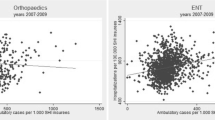Abstract
A linear regression procedure is usually used to estimate the effect of a set of predictors on utilization of ambulatory health care. The implicit assumptions embedded in the linear regression model have never been examined. Here, with utilization data of a sample of 48292 patients from the file of the Québec National Health Plan, four implicit hypotheses embedded in the linear regression model are tested: (1) the transition from the state of utilization to the state of no utilization, and vice-versa, depends on the level of the transition rates, (2) the effect of independent variables depends on the transitions being predicted from or to the state of utilization, (3) the transition is time dependent, and (4) the system of transitions from one state to another is not at equilibrium. The analysis shows that the first three hypotheses cannot be rejected. Thus, the use of the familiar linear regression procedure in this study to estimate the effect of a set of factors on utilization would have yielded biased estimates.
Similar content being viewed by others
References
AndersenA.S. & LaakeP. (1983). “A causal model for physician utilization: Analysis of Norwegian data”, Medical Care 21: 266–278.
BerkanovicE., TeleskyC. & ReederS. (1981). “Structural and psychological factors in the decision to seek medical care for symptoms”, Medical Care 19: 693–709.
BroylesR., MangaP., BinderD.A., AngusD.E. & CharetteA.. (1983). “The use of physician services under a national health insurance scheme: An examination of the Canada health survey”, Medical Care 23: 1037–1054.
ClearyP.D., MechanicD. & GreenleyJ.R. (1982). “Sex differences in medical care utilization: An empirical investigation”, Journal of Health and Social Behavior 23: 106–108.
ColemanJ.S. (1981). Longitudinal Data Analysis. New York: Basic Books.
DiehrP., MartinD.P., PriceK.F., FriedlanderL.J., RichardsonW.C. & RiedelD.C. (1984). “Use of ambulatory services in three provider plans: Interactions between patient characteristics and plans”, American Journal of Public Health 74: 47–51.
DuttonD.B. (1978). “Explaining the low use of health services by the poor: Costs, attitudes, or delivery systems?”, American Sociological Review 43: 348–368.
EricksonE.A. & MattsonL.G. (1983). “Quantitative measurement of continuity of care”. Medical Care 21: 858–875.
EvashwickC., RoweG., DiehrP. & BranchL. (1984). “Factors explaining the use of health care services by the elderly”, Health Services Research 19: 357–382.
HersheyJ.C., LuftH.S. & GianarisJ.M. (1975). “Making sense out of utilization data”, Medical Care 13: 838–864.
HulkaB.S., KupperL.L. & CasselJ.C. (1972). “Determinants of physician utilization: Approach to a service-oriented classification of symptoms”, Medical Care 10: 300–309.
InghamJ.G. & MillerP.M. (1983). “Self-referral: Social and demographic determinants of consulting behavior”, Journal of Psychosomatic Research 27: 233–243.
KilpatrickS.J. (1977a). “Consultation frequencies in general practice”, Health Services Research 12: 284–298.
Kilpatrick, S.J. (1977b). “An empirical study of the distribution of episodes of illness”, Journal of the Royal Statistical Society 26: Part I.
KuderJ.M. & LevitzG.S. (1985). “Visits to the physician: An evaluation of the usual service effect”, Health Services Research 20: 579–596.
LinkC.R., LongS.H. & SettleR.F. (1982). “Access to medical care under Medicaid: Differentials by race”, Journal of Health Politics, Policy and Law 7: 345–365.
McCallM. & WayH.S. (1983). “An analysis of the use of medicare services by the continuously enrolled aged”, Medical Care 21: 567–585.
MarkidesK., LevinJ.S. & RayL.A. (1985). “Determinans of physician utilization among Mexican Americans: A three generation study”, Medical Care 23: 236–246.
PopeC.R. (1982). “Life styles, health status, and medical utilization”, Medical Care 20: 402–413.
RoosN.P. & ShapiroE. (1981). “The Manitoba longitudinal study on aging: Preliminary findings on health care utilization by the elderly”, Medical Care 19: 644–657.
RoosN.P., ShapiroE. & RoosL.L. (1984). “Aging and the demand for health services: Which aged and whose demand?”, The Gerontologist 24: 31–36.
RundallT.G. & WheelerJ.R.C. (1979). “The effect of income on use of preventive care: An evaluation of alternatives”, Journal of Health and Social Behavior 20: 397–406.
ShapiroE. & RoosN.P. (1985). “Elderly nonusers of health care services: Their characteristics and their health outcome”, Medical Care 23: 247–257.
SharpK., RossC.E. & CockerhamW.C. (1983). “Symptoms, beliefs, and the use of physician services among the disadvantaged”, Journal of Health and Social Behavior 24: 255–263.
SmedbyB., SmedbyO.S., EricksonE.A., MattsonL.G. & LindgreenA. (1984). “Continuity of care: An application of visit-based measures”, Medical Care 22: 676–680.
SmedbyO., BlundG.E., EricksonE.A. & SmedbyB. (1986). “Measures of continuity of care: A register-based correlation study”, Medical Care 24: 511–518.
StollerP. (1982). “Patterns of physician utilization by the elderly: A multivariate analysis”, Medical Care 20: 1080–1089.
TannerJ.L., CockerhamW.C. & SpaethJ.L. (1983). “Predicting physician utilization”, Medical Care 21: 360–369.
ThomasJ.W. & PenchanskyR. (1984). “Relating satisfaction with access to utilization of services”, Medical Care 22: 553–568.
WanT.T.H. (1982). “Use of health services by the elderly in low income communities”, Milbank Memorial Fund Quarterly Health and Society 60: 82–102.
WanT.T.H. & OdellB.G. (1981). “Factors affecting the use of social and health serivices among the elderly”, Ageing and Society 1: 95–115.
WolinskyF.D. (1978). “Assessing the effects of predisposing, enabling and ilness-morbidity characteristics on health service utilization”, Journal of Health and Social Behavior 19: 384–396.
WolinskyF.D., CoeR.M., MillerD.K., PrendergastJ.M., CreelM.J. & ChavezM.N. (1983). “Health services utilization among the noninstitutionalized elderly”. Journal of Health and Social Behavior 24: 325–337.
WrightR., BergW.E. & CreecyR.F. (1980). “Health care utilization among the elderly: A causal analysis”, Journal of Social Service Research 3: 253–265.
Author information
Authors and Affiliations
Rights and permissions
About this article
Cite this article
Béland, F. Utilization of ambulatory care studies: testing the assumptions. Qual Quant 25, 137–150 (1991). https://doi.org/10.1007/BF00145702
Issue Date:
DOI: https://doi.org/10.1007/BF00145702




